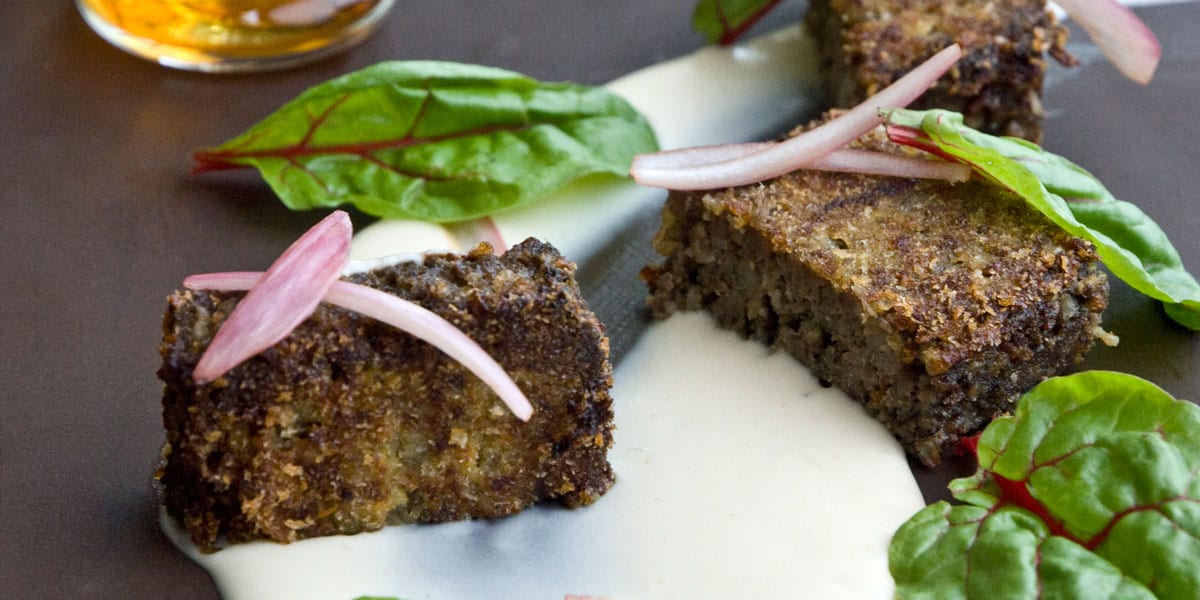Chef Kevin Gillespie, a Georgia- born chef of Scottish descent adapted the traditional Scottish dish to produce a milder version. The result is a country-style terrine that is served along side caramelized turnips and potatoes with a dollop of pickled shallots. Scottish food with a southern riff.
recipe 
yields
12 small plates
1 cup Scottish oats
8 ounces lamb’s tongue
8 ounce calf’s liver
Salt and pepper
1 teaspoon butter
1 soft-ball size onion finely chopped About 2 cups
2 cloves garlic minced about 1 tablespoon
2 tablespoons rubbed sage
2 teaspoons dried thyme
½ teaspoon ground allspice
½ teaspoon ground cinnamon
½ teaspoon ground cloves
1 pound ground lamb
¼-ounce packet powdered about 1 tablespoon or 4 sheets gelatin
1 cup beef stock (mushroom stock also works)
2 tablespoons Dijon mustard
1 cup finely ground Panko bread crumbs
2 tablespoons clarified butter
Caramelized Turnip and Potato Puree (recipe follows)
1½ cups Pickled Shallots,
Turnips, or Other Vegetables (recipe follows)
½ cup celery leaves or young micro herbs
Flake salt, sauch as Maldon
1 fist-size russet potato, peeled and cut into 1-inch cubes, about 2 cups
2 baseball-size turnips, peeled and cut into 1-inch cubes, about 2 cups
2 cups heavy cream
1 teaspoon salt
½ cup sugar
½ cup red wine vinega
1 pod star anise
1 piece, about 2 inches long cinnamon stick
3 allspice berries
6 shallots thinly sliced on a mandoline
Ingredients
Haggis
Pickled Shallots
Caramelized Turnip and Potato Puree
steps
“I adapted the traditional preparation to use milder-tasting calf’s liver, meaty lamb’s tongue for oomph, and some ground lamb to temper the intensity of the organ meats. I chill the cooked terrine, slice it thick, brush it with mustard, roll it in bread crumbs, and pan-fry it on one side in clarified butter. The texture of the finished haggis is a little like pâté with one crunchy fried side.”
– Chef Kevin Gillespie

Haggis
- Toast oats in 10-inch skillet over medium heat, shaking occasionally, until they smell nutty and turn light golden brown, about 5 minutes. Transfer to a plate and set aside to cool.
- Remove outer membrane from tongue and discard. Coarsely chop tongue and liver into 1-inch cubes, pat dry, and season with salt and pepper. Heat skillet over high heat, add butter, and swirl pan until butter is melted. Add tongue and liver and cook for 1 minute. Add onions and garlic and toss to combine. Cook just until onions start to brown on edges, about 2 minutes. Spread mixture on a baking sheet and cool to room temperature.
- In food processor fitted with metal blade, blend tongue and liver mixture until it starts to cream up, about 40 seconds. Blend in sage, thyme, allspice, cinnamon, cloves, mace, and 1 teaspoon black pepper. Mixture should have a little texture but no large chunks. Transfer to large bowl and, using large spoon or spatula, mix in toasted oats and ground lamb until thoroughly blended. Refrigerate until cold, about 30 minutes.
- In a small bowl, soften gelatin powder in ¼ cup of cold stock. Place remaining ¾ cup stock in small pan and bring to a boil over high heat. Remove pan from heat and whisk in gelatin mixture until completely dissolved. Stir in 2 tablespoons salt until dissolved. Transfer gelatin mixture to a metal bowl, stir in 4 ice cubes, and continue stirring until temperature of mixture drops to room temperature.
- Preheat oven to 275 degrees.
- Remove meat mixture from refrigerator and stir in gelatin mixture until well blended. Line 12-inch by 4-inch by 4-inch terrine mold with plastic wrap, leaving extra wrap overhanging edges. Spread meat mixture in mold and firmly tap mold on the counter to get rid of any air bubbles. Fold extra plastic wrap over top and, using a separate sheet of wrap, tightly cover mold. Wrap a piece of aluminum foil over plastic wrap and secure around edges of mold. Place lid on mold and place in baking dish or roasting pan with sides at least 1 inch higher than mold. Fill pitcher with warm water. Slide pan partially into oven and pour water into pan, filling it almost to top of mold. Carefully slide dish into center of oven, close door, and bake for 3 hours.
- Partially slide baking dish out of oven and carefully remove terrine from pan. Leave water-filled pan in oven to cool, so you can safely pull it out later. Remove lid, foil, and plastic wrap from terrine. Terrine should be cooked through and thermometer should register at least 185 degrees when inserted into center. If it isn’t, bake longer. Set terrine on rack and cool to room temperature, then cover it tightly and refrigerate until completely set—overnight is best. Or you can keep chilled haggis in refrigerator for up to 1 week.
- Before serving, preheat oven to 350 degrees.
- Using wet serrated knife, cut chilled haggis into slices about 1-inch thick. Brush one side with Dijon mustard and dip into panko. Heat 10-inch sauté pan over medium-high heat, add about 2 teaspoons of the clarified butter, and heat for 30 seconds. Gently slide 4 slices of haggis, panko side down, into hot butter. Cook until lightly browned, about 2 minutes. Don’t crowd pan; a 10-inch pan will comfortably hold 4 slices. Place skillet in oven to take chill off top side, about 2 minutes but not much longer. Remember, this is still a terrine and it can melt! Remove pan from oven and, using thin spatula, transfer slices to paper towels to drain. Repeat with other slices of haggis, or use three 10-inch sauté pans to warm all slices at once.
- For each serving, swirl about 2 tablespoons of the turnip and potato puree in center of a serving plate. Place haggis, browned side up, on puree, and garnish with pickled goods (shallots, turnips, or other pickled vegetables), celery leaves, and a sprinkle of flake salt.
KNOW YOUR OATS
Scottish oats are simply oat groats ground into small pieces with coarse stones. Irish or steel-cut oats are very similar but cut by steel instead of stone. Rolled oats are completely different because they are rolled flat. Rolled oats (old-fashioned, quick-cooking, or instant) will not work well in this recipe, but Irish, steel-cut, or pinhead oats will work fine.
Caramelized Turnip and Potato Puree
- Combine potatoes and turnips in 2 ½-quart heavy sauce-pan and add just enough cream to cover vegetables. Stir in the salt. Cover and bring mixture to a boil over high heat. Watch carefully because once it starts bubbling, it will boil over lightning fast! Remove lid and cut heat down to low. Simmer, without stirring, until mixture starts to separate and looks like it is curdling, about 1 ½ hours. Milk solids will sink to bottom of pan and form a thick coating, and vegetables will start to caramelize. I realize it’s hard not to stir, and it seems like a crazy long time, but you have to cook mixture this long without stirring for it to caramelize and develop a really rich flavor; you want cream to reduce down in volume and thicken so finished puree has silky texture.
- Pull pan from heat and use wooden spoon to scrape all browned bits from bottom of pan into mixture. Spoon vegetables into upright blender and add just enough of cooking cream to cover vegetables. Blend to smooth and velvety puree, about 2 minutes. Use rubber spatula to press puree through fine-mesh strainer for an even more velvety texture. Your puree will be similar consistency of thick custard.
Pickled Shallots
- Combine sugar, red wine vinegar, star anise, cinnamon, and allspice in medium saucepan and bring to a boil over high heat. Using slotted spoon, fish out whole spices and discard them. Add shallots and blanch in pickling liquid for 1 minute. Fish out shallots and spread them in single layer on a baking sheet; let cool to room temperature.
- Pour about half pickling liquid into an 8-ounce jar and cool to room temperature. Add shallots to pickling liquid in jar, cover, and store in refrigerator for up to 3 weeks.
share
- From Chef Kevin Gillespie of Revival and Gunshow in Atlanta, Georgia






